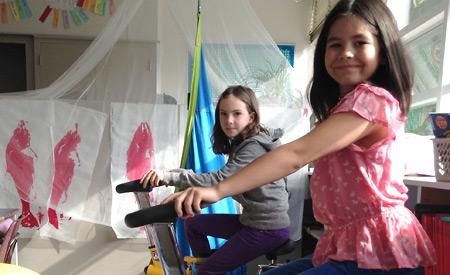A teacher at James Thomson Elementary School is being recognized nationally for creating a more inclusive classroom.
Sarah Shostak, who teaches a grade three/four split class at the Wildwood school, was nominated for the award from Canadian Association for Community Living and inclusion BC. She will receive the award at inclusion BC’s annual conference, May 28.
The award was created in response to an increasing number of students with special needs across the country who are put in separate classrooms when there are some needs for sensory outlets, said Karen DeLong, director of community development for inclusion BC.
DeLong added that Shostak’s teaching approach should be a model for teachers because it aims to be proactive and prevent disruptive behaviour before it begins.
Jasmin Marshman, principal at the school, said Shostak has always been interested in special education but this year she had a class with students who have a lot of different issues.
“It’s not just for those identified kids,” Marshman said. “It’s available for everyone and everyone in the class uses it.”
Shostak’s classroom includes a mini-sensory centre with the intent of creating a place for all students to get the most out of their learning experience.
“We have to work with what we have instead of trying to work against it,” Shostak said, adding that she was concerned about the amount of unstructured time that the students would have because of the school year ending early last year and starting late in the fall.
She designed her classroom to include a quiet, semi-enclosed part of the classroom where students can go to calm themselves but still be able to hear what is happening in the classroom, a rocking chair so they can have some movement while they work and a cocoon chair which wraps around the students sitting in it giving them a sense of enclosure and security.
All students sit on yoga balls or hokey stools which give students a chance to move a bit while they work. This helps students focus, said Shostak.
She uses something called a Yacker Tracker in her classroom to monitor the level of noise.
“It’s brilliant,” she said, explaining it is like a traffic light with three lights and measures the decibel level in the classroom. When the noise gets too high, the lights change, a visual prompt for students to quieten down. And it has worked for the class, Shostak said. At the beginning of the year the tracker recorded over 35 instances of the noise becoming too loud each day, but now there will maybe be three, she said. “I can’t believe where the class was in September and where they are at now,” she added.
She uses chimes and breathing exercises to bring the level of disruption in the classroom down if students are getting too excited.
Shostak received funding from the school’s Parent Advisory Committee and Powell River Cycling Association to buy three children’s stationary exercise bikes. The bikes are located at the back of the classroom and are set up so that students can use them as workstations while they silently pedal.
Marshman said that Shostak’s classroom with the bikes is serving as a pilot project for the whole school. “We would like to get a bike in each of the classrooms over the next few years. It’s been so successful.”



